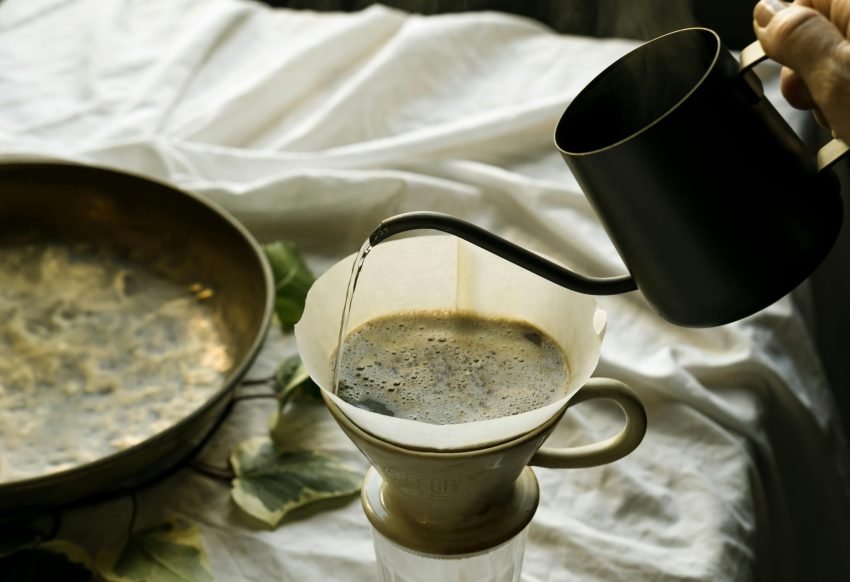In the world of beverages, few elixirs match the sheer complexity and satisfaction of a perfectly brewed cup of coffee. Beyond its stimulating aroma and rich flavor lies a world of intricate techniques and artistry that define the coffee brewing process.
In this article, we’ll explore coffee brewing techniques, delving into the nuances of flavor, aroma, and texture that each technique offers.
Understanding Coffee Beans and Grinders
Arabica vs. Robusta
Arabica, often hailed as the connoisseur’s choice, boasts a smoother, more nuanced flavor profile. Its acidity is balanced, offering delightful notes of sweetness, fruits, and florals. On the other side of the spectrum stands Robusta, renowned for its bold, robust taste. It’s higher in bitterness and carries a strong, almost woody flavor.
Arabica, with its delicate nuances, is favored by those who appreciate subtlety, while Robusta appeals to enthusiasts seeking a more robust and intense experience.
Roasting Levels and Their Impact on Flavor Profiles
Roasting is an art, and the level to which beans are roasted significantly influences their taste.
- Light roasts preserve the bean’s inherent characteristics, offering bright acidity and pronounced floral and fruity notes.
- Medium roasts strike a balance, enhancing the beans’ sweetness and body while retaining some acidity.
- Dark roasts, with their oil-covered surface, are characterized by rich, smoky flavors and reduced acidity.
Coffee Grinders: Burr vs. Blade Grinders
- Burr Grinders: Burr grinders, equipped with two abrasive surfaces, crush coffee beans between them. This method ensures a consistent grind size, vital for even extraction during brewing.
- Blade Grinders: Blade grinders, employing a rotating blade to chop coffee beans, are more affordable and readily available. However, they often produce uneven grind sizes, which can lead to inconsistent flavor profiles.
Popular Brewing Methods
Drip Brewing
Automatic Drip Coffee Makers: Automatic drip coffee makers feature a reservoir where water is heated and then dispersed over coffee grounds in a filter basket. As water seeps through the grounds, it absorbs flavors and oils, creating the aromatic brew that fills your carafe. The water-to-coffee ratio, the temperature, and the duration of contact all contribute to the final taste. Modern automatic drip machines often boast programmable features, allowing users to wake up to freshly brewed coffee.
Single-Cup Pod Systems: Single-cup pod systems, like Keurig and Nespresso, utilize pre-packaged pods containing coffee grounds. When a pod is inserted, the machine pierces it, hot water is forced through, and voila – a freshly brewed cup emerges. The beauty of single-cup systems lies in their variety; you can have a bold espresso in the morning, a flavored latte in the afternoon, and a calming herbal tea in the evening, all with a simple swap of pods. Each pod holds precisely measured coffee grounds, ensuring uniformity in every cup.
Pour-Over Brewing
Hario V60 Technique: The Hario V60, named for its 60-degree angle, is a cone-shaped dripper renowned for its ability to extract coffee’s nuanced flavors. The technique involves placing a paper or metal filter in the V60, adding finely-ground coffee, and slowly pouring hot water in a circular motion over the grounds. This method allows for meticulous control over variables like water flow rate and pouring pattern, influencing the extraction process. The result is a cup characterized by its clarity and complexity.
Chemex Brewing Method: The Chemex brewing method involves placing a thick paper filter in the upper chamber, adding coarsely-ground coffee, and pouring hot water over the grounds in intervals. The design of the Chemex allows for a slower extraction process, accentuating the coffee’s subtle flavors. The thick filter eliminates sediment, resulting in a remarkably clean cup. Chemex brewing emphasizes the purity of coffee, highlighting its natural sweetness and floral notes.
French Press Brewing
Mastering the Plunge: Step-by-Step Guide
Mastering the art of the French press plunge requires finesse and timing.
- Begin by coarsely grinding your coffee beans, ensuring an even extraction. Use a coarse grind; the larger particles prevent over-extraction, resulting in a smooth cup with depth.
- Preheat the French press with hot water before adding coffee grounds and water maintains an even temperature throughout the brewing process, enhancing the extraction.
- Add the grounds to the French press and pour hot water over them. The coffee-to-water ratio is crucial; a standard ratio is one ounce of coffee to 15 ounces of water, but adjusting this according to taste preferences can enhance richness. Consider water temperature; aim for water between 195°F to 205°F, ensuring optimal extraction without scalding the grounds.
- Let the coffee steep for about four minutes; this duration is pivotal, allowing the water to extract the flavors without over-extraction bitterness. A longer steeping period, around four to five minutes, can intensify flavors, producing a bold cup.
- Once the steeping time is up, press the plunger down slowly and steadily. The pressing process should take about 20-30 seconds, ensuring that the metal or mesh filter separates the coffee grounds from the liquid thoroughly. Applying too much force too quickly can lead to over-extraction, while being too gentle might result in a weaker brew.
Espresso Brewing
Espresso Machines: Semi-Automatic vs. Super-Automatic
- Semi-Automatic Espresso Machines: th a semi-automatic machine, baristas have the freedom to manually start and stop the brewing process, adjusting the shot length according to the coffee’s flavor profile. This hands-on approach allows enthusiasts to experiment, fine-tuning variables like grind size and tamping pressure to achieve a personalized and perfectly balanced shot of espresso.
- Super-Automatic Espresso Machines: Super-automatic machines, on the other hand, automate the entire espresso brewing process. Super-automatic machines often feature programmable settings, allowing users to adjust parameters like shot volume and strength. While they sacrifice some of the control found in semi-automatic machines, they provide unparalleled convenience, making them ideal for busy households or commercial settings where consistency and efficiency are paramount.
Grinding, Tamping, and Extraction
- Grinding: Espresso requires a fine and consistent grind size; too coarse, and the water flows through too quickly, resulting in a weak shot, while too fine can lead to over-extraction, making the espresso bitter.
- Tamping: Tamping, the act of pressing the coffee grounds evenly in the portafilter, is a critical step.Baristas often use a tamper with a flat, level surface to achieve an even tamp, vital for producing a balanced shot. The ideal pressure, typically around 30 pounds, compresses the grounds just enough to create resistance without impeding water flow.
- Extraction: The extraction process, where hot water is forced through the tamped coffee grounds, should last between 25 to 30 seconds. This duration allows the water to dissolve the coffee’s soluble compounds, extracting the flavors and aromas.
AeroPress Brewing
The AeroPress, designed as a portable and efficient brewing device, operates on a simple yet ingenious principle. Ground coffee is steeped in hot water, and the resulting coffee is then forced through a filter by air pressure. This approach combines elements of immersion and pressure brewing, allowing for a remarkably efficient extraction. The use of air pressure ensures a consistent brewing environment, promoting even extraction and full-bodied flavors.
The AeroPress is prized for its adaptability. Users can experiment with variables such as water temperature, steeping time, and the coffee-to-water ratio, tailoring the process to individual taste preferences. Its versatility extends to the ability to brew both regular and concentrated coffee, accommodating diverse beverage choices.
Cold Brew
Cold brew involves steeping coarsely ground coffee beans in cold water for an extended period, typically 12 to 24 hours, resulting in a coffee concentrate. The slow steeping process extracts flavors without the acidity found in hot-brewed coffee, delivering a smoother, milder taste. Cold brew aficionados relish its versatility; it can be served over ice, diluted with water or milk, and flavored with syrups or spices. Variations like vanilla-infused or cinnamon-flavored cold brews tantalize taste buds, offering a refreshing alternative to traditional hot coffee.
In our exploration of the diverse and intricate world of coffee brewing techniques, we’ve journeyed through the classic and the innovative, the traditional and the avant-garde. Each technique, a chapter in the story of coffee, offers a unique experience, a nuanced flavor profile, and a delightful ritual.
May your adventures be rich, your flavors be bold, and your love for coffee be boundless. Here’s to a world brewing with endless possibilities and to the exciting chapters waiting to be written in your coffee story.


